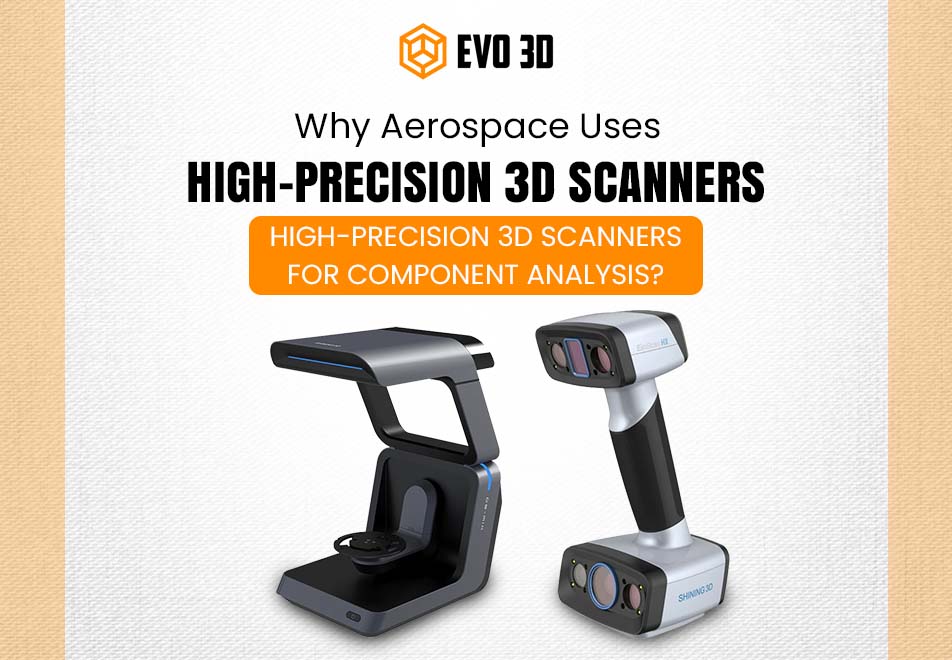Why Aerospace Uses High-Precision 3D Scanners for Component Analysis?

We are all aware that the aerospace industry is a rapidly growing and innovative sector today. It is a well-known fact that traditional production methods require a significant amount of time to achieve precise measurements and quality assurance.
In the aerospace industry, a millimetre of error can lead to critical failures, so accuracy is non-negotiable. This is where high-precision 3D scanners come into play.
Engineers can capture exact dimensions of complex components from turbine blades to airframe structures with the help of 3D scanning. The data collected helps in reverse engineering, quality inspection, and even failure analysis.
3D scanners can help create digital replicas in minutes, reducing labour and human errors. They give the aerospace sector the ability to analyse wear and tear over time. By integrating 3D scanners into their workflow, aerospace companies gain faster turnaround times with improved product development cycles.
As the demand for lighter, more efficient aircraft grows, so too does the need for tools that can support such innovation. 3D scanners are at the forefront of that transformation.
How Does a 3D Scanner Improve Component Analysis in the Aerospace Sector?
Do you know how aerospace teams catch invisible flaws before they become dangerous problems? Behind every successful flight is a deep commitment to accuracy. Engineers aren’t just building machines; they are protecting lives in the sky. And to do that, they need tools and technology they can fully rely on.
That’s where the 3D scanner plays an important role. It not only scans a part but also reveals slight deviations and inconsistencies that are impossible to catch with the naked eye.
Whether it's a part fresh off the production line or one that's been in service for years, the scanner captures every angle and dimension with remarkable clarity.
This insight helps experts decide whether a component is ready to fly or needs further inspection. It’s a smart fusion of technology and trust, helping aerospace professionals stay one step ahead of risk. It is because in this industry, knowing more means flying safer. Want to know how 3D scanners enhance component analysis in the aerospace industry? Continue reading below.
Accuracy and precision
It is known that in the aerospace industry, precision is everything and margin for errors should be minimal. Imagine an aerospace engineer has just received a highly complicated component packed with complex dimensions and details. Capturing these nuances with traditional tools is time-consuming and is prone to inaccuracies. With 3D scanners, engineers can achieve high accuracy levels as they scan the entire surface of a component, capturing each detail to generate a detailed digital model.
These 3D scans are beneficial for replicating exact replicas of aerospace parts or generating new designs based on existing components. Engineers and QA specialists can make use of digital data to improve designs. This helps in ensuring maximum efficiency without any human error.
Accelerating reverse engineering
Reverse engineering plays an important role in aerospace, whether for maintenance, repair, or aftermarket modification. This process of reverse engineering involves capturing the dimensions of a component. 3D scanning is the perfect way to capture these dimensions. Engineers can create a model from a large format 3D printer. This model is further scanned using a 3D scanner and used for design, analysis, or manufacturing.
The benefit of using 3D scan data is its ability to highlight even the most minor discrepancies that can be missed in traditional inspection methods. For instance, an aerospace part might seem to be in good condition, but 3D scanning can reveal minor cracks or distortions that could eventually lead to failure. Detecting these minor failures helps engineers make important decisions related to repair or design improvements. This ultimately enhances the safety and performance of the aircraft.
Aerospace simulation and performance analysis
The value of an industrial 3D scanner in aerospace goes well beyond reverse engineering or quality checks. One of its most impactful uses lies in generating precise digital models that feed into advanced simulation tools, helping engineers anticipate how a component will perform under real-world conditions.
For example, in jet engine development, data from a 3D scanner can be used to simulate how turbine components respond to extreme heat or pressure, long before they are ever installed. In airframe engineering, complex shapes like winglets can be scanned and virtually tested for aerodynamic performance, allowing for fine-tuned design improvements.
By integrating 3D scanner output with simulation software, teams gain deeper insights about structural durability. Engineers can pinpoint potential weak points or failure-prone zones.
This proactive approach enables aerospace engineers to optimise designs early in the development cycle, reducing prototyping costs and increasing overall reliability.
In a field where failure isn’t an option, a 3D scanner becomes an essential tool for predictive analysis and smart design innovation.
Discover The Impact Of 3d Scanners on Aerospace Analysis.
To conclude, 3D scanning is transforming the aerospace industry, from design to production to maintenance and repair. By capturing every minute detail and highlighting failures, these technologies are improving efficiency and accuracy across the aerospace sector.
Whether you are designing new aerospace components or maintaining legacy parts, the power of 3D scanning is undeniable. At Evo3D, we provide advanced 3D scanners that empower aerospace engineers to innovate, inspect, and produce with unmatched accuracy.
Are you looking forward to integrating 3D scanning into your aerospace workflows? Connect with us today and take your operations to the next level.
